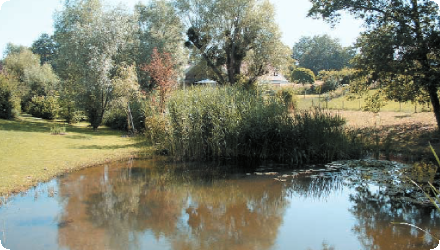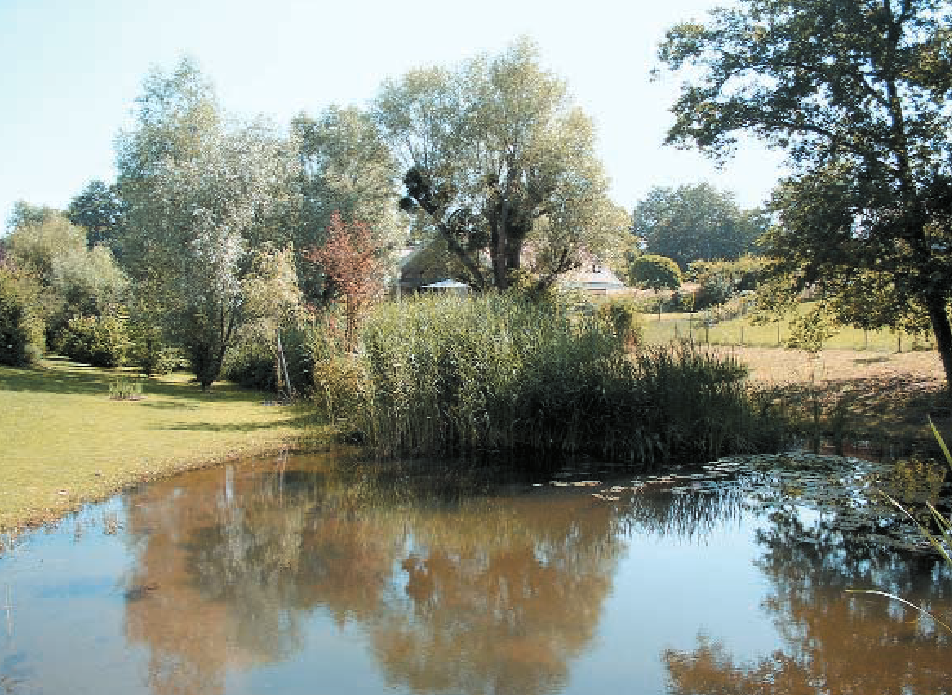Last update
2025
Summary
Located in Chêne-Bougeries (Geneva canton), this 1995 retention pond demonstrates NWRM in a dense urban plot. The small biotope (~300 m²) stores about 450 m³ on-site and contributes ~279 m³ at the 3.1-ha catchment scale, reducing storm runoff and flood risk. Design details include a lined basin (plastic membrane over sand; clay subsoil), a 1.2-m earth embankment with two overflows (primary outlet limiting discharge to ~48 L/s; emergency crest), and a ~150-m open swale collecting parcel runoff. The pond maintains permanent water (~0.5 m; max depth ~1.6 m); the safety overflow reportedly activated only once, and the basin has not dried out. Works were completed in ~2–3 months (1995) for ≈ CHF 60,000. Maintenance is shared by adjacent owners (annual vegetation removal). Reported benefits include habitat for amphibians, fish and odonates and a reduction in mosquito nuisance. Subsequent ecological survey work in Geneva (2015 sampling; 2018 publication) confirms continued use by amphibians at Étang Vieux-Clos. The approach aligns with the canton’s ongoing strategy to manage stormwater “à ciel ouvert”, with new retention/biotope projects under development nearby.
Position
Latitude
46.197778
Longitude
6.187778
Project
NWRM
National Id
Switzerland_03
Installation date
1995
Contact
Anais Hanus, ACTeon
RBD code
CH50
Transboundary
0
Photo gallery
Location of the project
At the junction of Chemin du Vieux-Clos and Chemin de Vert-Pré, Conches (Chêne-Bougeries); small valley bottom.
NUTS Code
CH07 - Ticino
Project's objectives
Attenuate storm peaks by ~450 m³ storage (BV retention ~279 m³), cap outflow ~48 L/s, and maintain ≥ 0.5 m permanent water to support aquatic biota; dimensioned for T=10 years events.
Involved Partners
| Authority type | Authority name | Role | Comments |
|---|---|---|---|
Climate zone
cool temperate moist
Temperature
10,10
Precipitation
942
Annual rainfall range
900 - 1200 mm
Runoff
54
Runoff coefficient
0,25
Runoff range
0 - 150 mm
Elevation range
422
Slope range
1-2%
Vegetation class
Within the pond: reeds (roseaux), water lilies (nénuphars) and other aquatic macrophytes; along the ~150 m open swale, reed-rich, moisture-loving vegetation.
Water bodies: Ecological Status
Moderate
Water bodies: Chemical Status
Good
Water quality status
Urban Seymaz: historic channelization & limited space, urban runoff, and recurrent pollution episodes; biological quality historically poor, renaturation ongoing.
Project scale
Micro
Project scale specification
a single on-plot retention biotope within a villa subdivision (~3.2 ha parcel; BV ~30,800 m²)
Performance timescale
< 1 year
Project area
3,2 ha
Area subject to Land use change or Management/Practice change (ha)
0,0299999993294477
Size
300
Size unit
m2
Lifespan
100
Design capacity description
The pond itself can retain 460m3; the estimated volume of retained water for the whole watershed is 279m3
A natural 3 ha depression/valley (NW–SE), clay subsoil (quasi-impermeable), and an undersized existing collector favored an on-site retention biotope over costly pipe upgrades.
Total cost
CHF 60,000
Costs operation maintenance
49000
Financing authorities
Type of funding
Local funds
Type of funding
Private funds
Comments
Private owners finance vegetation maintenance
Policy context
Privately owned parcels with an internal regulation and shared maintenance; built after rezoning to villa zone (1990s) to mitigate runoff from urbanization. Aligns with canton policy promoting parcel-level stormwater retention and current “à ciel ouvert” strategy.
Land ownership
Private villa-plot owners at Conches. The pond/biotope spans parcels with an internal owners’ regulation; upkeep costs are shared pro-rata.
Community involvment
No
Design consultation activity
| Activity stage | Name | Key issues | Comments |
|---|
Policy target
| Target purpose |
|---|
|
Increase Water Storage
|
|
Improved Biodiversity
|
|
Oher Societal Benefits
|
Policy pressure
| Pressure directive | Relevant pressure |
|---|
Policy impact
| Impact directive | Relevant impact |
|---|
Requirement directive
| Requirement directive | Specification |
|---|
Contractual arrangements
0
| Arrangement type | Responsibility | Role | Name | Comments |
|---|
Part of wider plan
0
Wider plan type
| Wider plan type | Wider plan focus | Name | Comments |
|---|---|---|---|
|
National
|
Water
|
federal law on water protection, 24 january 1991
|
|
|
Local
|
Water
|
Cantonal law on water (L 2 05)
|
Unknown
null
The pond reduce runoff in the area and the damages it can generate
The pond provides a "natural" area which can be used as recreative area for neighboring private owners. It also contributed to reduce mosquitos density.
Information on retained water
Peak-flow attenuation and temporary storage (~450 m³ on-site; ~279 m³ at BV scale), controlled discharge (~48 L/s), and creation of a small hydromorphic biotope; infiltration limited by clay.
Increased water storage
90
Increased water storage unit
m3/ha
Information on increased water storage
279m3 can be retained at the watershed scale (3,1ha)
Water quality overall improvements
Not relevant for this application
Soil quality overall soil improvements
Not relevant for this application
1
The pond provide habitat for fauna and flora, including aquatic flora
Ecosystem impact climate regulation
No information available
Ecosystem provisioning services
0
Key lessons
Example of how to retain water in urban areas.
Its success lead to the easy implementation of new water management projects in the city, for example a new retention pond project was presented to the public in 2025.
Its success lead to the easy implementation of new water management projects in the city, for example a new retention pond project was presented to the public in 2025.
Success factor(s)
| Success factor type | Success factor role | Comments | Order |
|---|---|---|---|
|
Attitude of relevant stakeholders
|
main factor
|
<p>Since private owners are responsible for maintaining vegetation on their plots, the measure efficiency partly depends on their attitude</p>
|
1
|
|
Legal obligations
|
secondary factor
|
<p>Legal obligations can lead stakeholders to implemnt measures to retain water in urban areas</p>
|
2
|
Driver
| Driver type | Driver role | Comments | Order |
|---|---|---|---|
|
Other
|
main driver
|
The main driver which led to consider the measure was the new status of the land which became available to be constructed; water management became a major issue.
|
1
|
|
Other
|
main driver
|
The measure was estimated cheaper than another project (re-build existing infrastructures)
|
2
|
|
Legal obligations
|
main driver
|
The federal law on water protection requests rain water infiltration in urban areas through retention measures
|
3
|
|
Organisation committed to it
|
secondary driver
|
Geneva Canton elaboraed recommandations regarding water retention in urban areas
|
4
|
Transferability
Highly transferable to low-gradient suburban plots. Key cautions: ensure legal servitudes/owner agreements, safe overflow paths, vector control by predators (avoid stagnant edges), and clear O&M.
English

